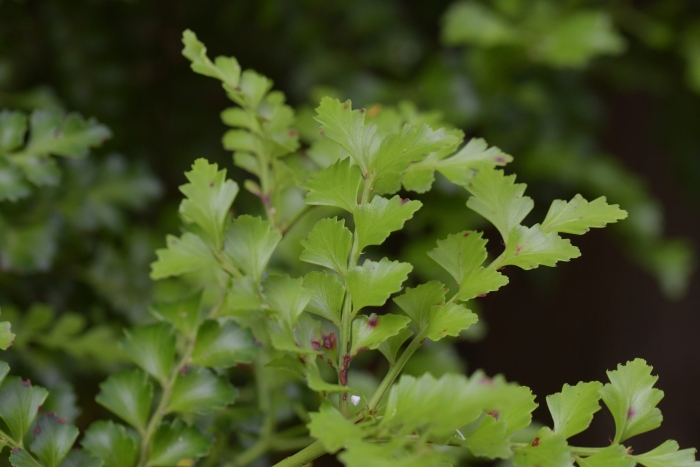Tānekaha
(Phyllocladus trichomanoides)
Tānekaha (Phyllocladus trichomanoides)
/
/

Christopher Stephens
CC BY-SA 4.0
Image By:
Christopher Stephens
Recorded By:
Copyright:
CC BY-SA 4.0
Copyright Notice:
Photo by: Christopher Stephens | License Type: CC BY-SA 4.0 | License URL: http://creativecommons.org/licenses/by-sa/4.0/ | Rights Holder: Christopher Stephens | Publisher: iNaturalist | Date Created: 2021-01-16T09:34:12-08:00 |
























Estimated Native Range
Summary
Phyllocladus trichomanoides, commonly known as tānekaha or celery pine, is a coniferous tree endemic to New Zealand. It is a medium-sized tree that can grow up to 82 feet (25 meters) in height and is notable for its green-skinned shoots that turn brown as the bark thickens. The leaves are sparse and scale-like, with leaf-like phylloclades taking on the primary role of photosynthesis. The seed cones resemble berries with a fleshy white aril. Tānekaha is found in lowland and montane forests, often in association with podocarp and broadleaf species, from Te Paki to Marlborough and Nelson. It provides habitat for the New Zealand endemic beetle Agapanthida morosa.
Tānekaha is valued for its strong, knot-free timber, which is used in construction and fine woodworking. The tree is also appreciated for its unique appearance and is sometimes planted in larger gardens and parks. In cultivation, it requires well-drained soil and can tolerate a range of light conditions from full sun to partial shade. Tānekaha is relatively low-maintenance but can be susceptible to root rot if planted in poorly drained soils. It is not known to be invasive when grown outside its native range, and there are no significant disease issues reported.CC BY-SA 4.0
Tānekaha is valued for its strong, knot-free timber, which is used in construction and fine woodworking. The tree is also appreciated for its unique appearance and is sometimes planted in larger gardens and parks. In cultivation, it requires well-drained soil and can tolerate a range of light conditions from full sun to partial shade. Tānekaha is relatively low-maintenance but can be susceptible to root rot if planted in poorly drained soils. It is not known to be invasive when grown outside its native range, and there are no significant disease issues reported.CC BY-SA 4.0
Plant Description
- Plant Type: Tree
- Height: 20-66 feet
- Width: 10-20 feet
- Growth Rate: Slow
- Flower Color: N/A
- Flowering Season: Non-Flowering
- Leaf Retention: Evergreen
Growth Requirements
- Sun: Full Sun, Part Shade
- Water: Medium
- Drainage: Medium, Fast
Common Uses
Low Maintenance, Potted Plant, Rock Garden
Natural Habitat
Native to lowland and montane forests in New Zealand, often in association with podocarp and broadleaf species
Other Names
Common Names: Tanekaha, Mountain Toatoa
Scientific Names: , Phyllocladus trichomanoides, Phyllocladus alpinus,
GBIF Accepted Name: